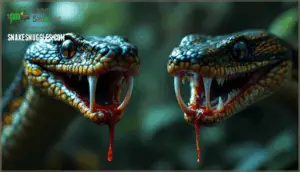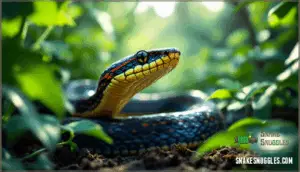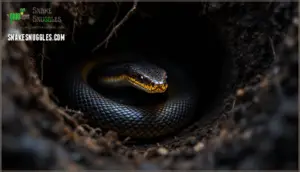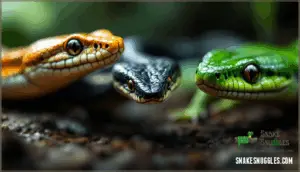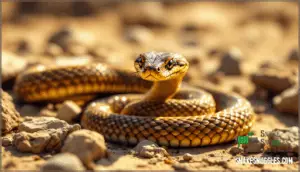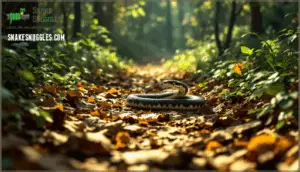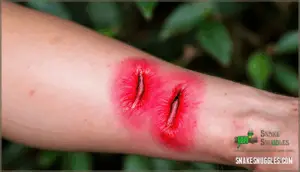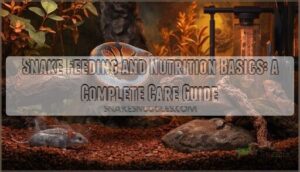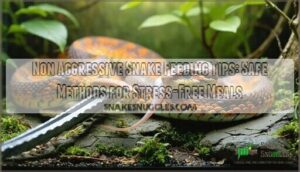This site is supported by our readers. We may earn a commission, at no cost to you, if you purchase through links.
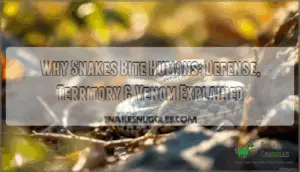 Most people don’t realize that snakes bite humans by accident. Unlike predators hunting for a meal, snakes strike at humans purely out of fear—they’re trying to survive an encounter with something a hundred times their size.
Most people don’t realize that snakes bite humans by accident. Unlike predators hunting for a meal, snakes strike at humans purely out of fear—they’re trying to survive an encounter with something a hundred times their size.
The serpent coiled near your hiking boot isn’t plotting an attack. It’s terrified. When you step too close to a basking rattlesnake or reach into brush where a copperhead hides, you trigger an ancient defensive reflex honed over millions of years.
Understanding this shift in perspective changes everything about how you navigate snake country and what to do when you spot those telltale scales.
Table Of Contents
- Key Takeaways
- Snake Behavior and Biting
- Types of Venomous Snakes
- Why Snakes Attack Humans
- Snake Venom and Its Effects
- Snakebite Prevention and Safety
- Snakebite Symptoms and Diagnosis
- Treatment and Antivenom for Snakebites
- Frequently Asked Questions (FAQs)
- Why do snakes try to bite you?
- Why do some snakes attack humans?
- What is the cause of snake bite?
- How do you stop snakes from biting you?
- Can snakes bite multiple times during an attack?
- What are the long-term effects of a snakebite?
- How can I identify a venomous snake bite?
- What should I do if I witness someone getting bitten?
- Are there any natural remedies for snakebite treatment?
- How many people survive snake bites worldwide?
- Conclusion
Key Takeaways
- Snakes bite humans purely as a defensive reaction when they feel threatened or cornered, not out of aggression or intent to hunt—you’re simply too large to register as prey.
- Recognizing warning signs like hissing, coiled postures, or rattling gives you critical seconds to back away before a snake resorts to striking as its last defensive option.
- Wearing thick boots and long pants, staying on cleared trails, and avoiding tall grass or rocky areas during warm months dramatically reduces your snakebite risk.
- Prompt medical attention after a venomous bite is essential—antivenom works best within hours, and delays can turn manageable injuries into permanent damage or death.
Snake Behavior and Biting
Snakes don’t bite out of malice—they bite because something in their world doesn’t feel right. Understanding what drives these actions can help you avoid unwanted encounters and respect the boundaries snakes set.
Let’s break down the key reasons snakes strike, from defense to dinner time.
Defensive Mechanisms in Snakes
Snakes don’t carry "fight or flight" insurance—they rely on a toolkit of defenses long before they resort to biting. Camouflage lets them vanish into leaf litter or sand, avoiding confrontation altogether. Hissing sounds serve as acoustic warnings—think of it as nature’s "back off" signal.
Some species use mimicry, copying the color patterns of venomous snakes to bluff predators. Defensive postures like flattening their bodies or coiling tight make them look more intimidating. These mechanisms reduce the need for actual snakebite incidents, conserving venom for hunting rather than self-defense.
Territorial Behavior and Biting
While camouflage and hissing keep most conflicts at bay, some snakes will bite to defend a claimed space—especially during breeding season or when guarding a reliable food source. Territory defense isn’t about malice—it’s survival instinct. Habitat overlap brings you closer to snake encounters, particularly where:
- Dense vegetation conceals basking sites
- Rock crevices shelter mating pairs
- Rodent burrows attract hunting snakes
- Water sources concentrate competing species
- Agricultural fields create resource competition
Recognizing territorial displays reduces your risk when hiking or working outdoors.
Hunting and Feeding Habits
Most snakes bite humans only when startled or cornered, but when they’re hunting, their strikes are calculated, efficient, and meant for prey far smaller than you.
Snake conduct during feeding revolves around precise prey selection and venom usage:
- Rodents, amphibians, and birds trigger feeding responses
- Ambush predators rely on camouflage and patience
- Venom types evolved to immobilize specific prey quickly
- Feeding frequency depends on habitat influence and meal size
You’re simply too large to register as food.
Social Interactions and Biting
Beyond hunting, snakes bite each other—and occasionally you—when competing for mates or defending breeding territory. During mating rituals, males engage in agonistic action and dominance displays, using communication signals to establish social hierarchy.
If you stumble into their breeding zone, defensive mechanisms kick in fast. Watch for hissing, coiled postures, or head-raising—these territorial action cues mean back off now.
Types of Venomous Snakes
Not all venomous snakes deliver their venom the same way. The position and structure of their fangs determine how they strike and inject toxins.
Here’s a breakdown of the major venomous snake families you should know about.
Front-Fanged Snakes (Viperidae and Elapidae)
You’ll encounter two major groups of front-fanged venomous snakes: Viperidae and Elapidae. Vipers pack long, hinged fangs that fold back, delivering hemotoxins deep into tissue—causing hemorrhage and tissue destruction. Elapids, like cobras and mambas, use shorter, fixed fangs to inject neurotoxins that target your nervous system, potentially triggering paralysis.
These snakes have a precise venom delivery. These distinct fang morphologies and venom toxicity patterns drive different snakebite outcomes worldwide, with global epidemiology showing these families cause most life-threatening envenomations.
Rear-Fanged Snakes (Colubridae)
Unlike vipers and elapids, rear-fanged snakes in Colubridae use grooved posterior fangs and a low-pressure venom delivery system. Their Duvernoy’s gland produces diverse toxins—dominated by CRiSPs, metalloproteinases, and three-finger toxins—but requires chewing to inject venom effectively. Understanding venom secretion mechanisms is essential for comprehending their unique envenomation process.
While most rear-fanged snakebites cause only mild local swelling, genera like Boiga and Philodryas warrant caution. Their medical significance remains low, yet toxin diversity shows bioprospecting potential for future therapeutics.
Atractaspididae (Stiletto Snakes)
Few snake families inspire more wariness among field herpetologists than Atractaspididae—commonly called stiletto snakes—which can stab sideways with elongated front fangs even while being held behind the head. Their subterranean lifestyle and unique fangs make them particularly hazardous.
Stiletto venom contains sarafotoxins that cause severe cardiovascular effects:
- Lateral fang strikes bypass standard safety practices
- Potent cardiotoxic components trigger dangerous symptoms
- Limited research means antivenom remains scarce
You won’t find many bite severity studies—encounters are rare, but potentially lethal.
Other Venomous Snake Families
When most people think of venomous snakes, they picture cobras and rattlesnakes—but some of the world’s deadliest serpents belong to families you’ve probably never heard of. Take the inland taipan—its neurotoxins deliver venom potency exceeding any other snake. Australia’s geographic distribution harbors this recluse, while Africa’s black mamba strikes with terrifying speed.
Understanding these types of venomous snakes and their evolutionary origins keeps you safer in snake country.
| Species | Bite Severity & Venom |
|---|---|
| Inland Taipan | Extreme neurotoxic venom; rarely encounters humans |
| Black Mamba | Rapid onset neurotoxins; aggressive when cornered |
| Boomslang | Rear-fanged hemotoxic venom; conservation status stable |
Why Snakes Attack Humans
Snakes don’t set out looking for trouble with humans—they bite when they feel cornered or threatened. Understanding what triggers these defensive strikes can help you avoid dangerous encounters.
Let’s look at the four main reasons snakes lash out at people.
Fear and Self-Defense
Most people don’t realize that a snake’s bite isn’t an act of aggression—it’s a last resort. When you approach too quickly or corner one, its fight-or-flight response kicks in. Defensive biting happens because the snake perceives you as a threat to its survival. Understanding these defensive mechanisms helps clear up common snake misconceptions about unprovoked attacks.
Why snakes bite humans in self-defense:
- Sudden movements trigger strike reflexes – quick gestures mimic predator actions
- Escape routes blocked – cornered snakes have no alternative
- Human provocation misread as attack – accidental steps or reaching hands
- Self-preservation overrides retreat – defensive reactions protect vulnerable bodies
Territorial Protection
Territory isn’t just a concept for snakes—it’s survival, and they’ll defend their patch of ground with fangs bared if you push too close. Territorial conduct kicks in when you wander into spaces they’ve claimed—dens, basking rocks, or hunting grounds.
During mating season, males become especially aggressive, guarding their territories and potential mates from perceived intruders. Nest guarding intensifies this defensive response; gravid females won’t hesitate to strike if you threaten their eggs or young. Watch for aggressive displays like coiling, rattling, or raising the head—these are your final warnings.
Resource defense matters too. Limited water sources or prey-rich areas make snakes less tolerant of trespassers. Understanding these territorial protection patterns helps you recognize when you’ve crossed invisible boundaries that trigger defensive mechanisms in snakes, turning provocation into a strike.
Mistaking Humans for Prey
Misidentifying a threat doesn’t always mean you’re on the defensive—sometimes your limb mimics prey. Male sea snakes demonstrate this confusion strikingly during mating season, approaching divers in over 74 recorded cases. Poor underwater visual acuity forces them to rely on chemical cues and shape recognition, leading to prey misidentification. Yet genuine predatory attacks remain exceptionally rare—less than 0.3% of all snakebites—because size discrepancy becomes obvious upon contact.
Watch for these mistaken identity triggers:
- Rapid movements resembling fleeing prey
- Seasonal correlation with breeding periods
- Snake habitats overlapping human activity
- Low visibility affecting snake identification
- Hunting and feeding habits during active hours
Most bites are "dry," with snakes quickly recognizing their error.
Provocation and Handling
You’d be surprised how often the biggest danger isn’t the snake itself—it’s the impulse to grab it. Approximately 40% of venomous bites result from intentional provocation and interaction, particularly during capture attempts.
Captivity bites spike when people misread defensive postures—flattened necks, coiled bodies, rapid tongue-flicking. Snake aggression escalates with unnecessary interaction.
Secure management and removal of snakes require understanding species-specific actions. Your best snake bite prevention strategy? Observe from a distance and contact professionals for removal.
Snake Venom and Its Effects
Snake venom isn’t a single substance—it’s a complex cocktail of proteins and enzymes that varies dramatically between species. Understanding these differences can help you grasp why some bites cause tissue damage while others attack your nervous system.
Here’s how the major venom types work their way through your body.
Haemotoxic Venom (Viperidae)
Viper venom contains haemorrhagins, enzymes that shred blood vessels from the inside out. When these snakes strike, victims face coagulopathy effects, swinging from uncontrolled bleeding to dangerous clotting. Endothelial damage occurs rapidly, with over 40% of victims developing bleeding manifestations.
Delayed treatment beyond six hours risks kidney injury and life-threatening hemorrhage. Antivenom, costing around $78 per dose, is the best defense against snakebite symptoms that could otherwise prove fatal.
Neurotoxic Venom (Elapidae)
Elapid venom takes a different approach—instead of destroying tissue, it hijacks your nervous system like a stealthy saboteur cutting communication lines. These neurotoxins from venomous snakes like cobras block nerve signals at synapses, causing:
- Paralysis effects—muscles stop responding to commands
- Respiratory failure—diaphragm paralysis threatens breathing
- Anticholinesterase drugs—emergency treatment that reverses neurotoxin mechanism
Without antivenom, snakebite symptoms progress rapidly as Elapidae venom shuts down essential functions.
Cytotoxic Venom (Rattlesnakes)
Rattlesnake venom works like a biochemical wrecking ball, demolishing tissue at the cellular level through cytotoxic compounds that trigger widespread necrosis. Local effects—intense swelling, blistering, and blackened tissue—are visible as cytotoxins destroy cell membranes. The venom composition includes enzymes that literally digest surrounding tissue.
Treatment options depend on rapid antivenom administration; delay turns manageable tissue damage into permanent disfigurement or limb loss.
Other Venom Types (Myotoxins, Cardiotoxins, Sarafotoxins)
Beyond the usual suspects of haemotoxins and neurotoxins, some snake venoms pack specialized toxins—myotoxins that shred muscle fibers, cardiotoxins that disrupt your heartbeat, and sarafotoxins that wreak havoc on blood vessels. These venom effects often work in deadly combinations:
- Myotoxins – Destroy skeletal muscle tissue, causing rhabdomyolysis
- Cardiotoxins – Trigger arrhythmias and cardiac arrest
- Sarafotoxins – Constrict vessels, spiking blood pressure dangerously
- Venom synergies – Multiple toxin types increase damage exponentially
Research gaps remain vast in understanding these complex venom interactions.
Snakebite Prevention and Safety
Most snake bites happen because people don’t see them coming. You can’t avoid every encounter, but smart habits stack the odds in your favor.
Here’s what works when you’re in snake country.
Avoiding Snake Habitats and Areas
The best defense against a snakebite is staying out of harm’s way. Avoid tall grasses and wooded areas where snakes rest or hunt—stick to cleared trails for solid trail safety. Habitat awareness matters year-round, though seasonal precautions become critical during warmer months when snakes are most active.
If you’re hiking remote terrain, pack remote first-aid supplies and learn basic snake relocation techniques. Don’t reach into brush or under rocks without checking first.
Wearing Protective Clothing and Gear
Thick boots and long pants aren’t fashion statements in snake country—they’re your first line of defense against fangs that can pierce denim and leather. Protective gear with proven bite resistance reduces envenomation risk considerably:
- Leather boots extending above the ankle provide critical garment coverage where most strikes occur
- Canvas or thick denim pants offer material durability without compromising mobility impact
- Gloves and gaiters complete your protective clothing setup for high-risk areas
Cost analysis shows that quality gear prevents expensive medical treatment.
Being Aware of Surroundings and Snakes
Most snake encounters happen because you’re not watching where you step—and snakes won’t announce themselves with a warning label. Scan the ground ahead, especially near rocks, logs, and dense vegetation where snake habitats concentrate. Listen for audible clues like rattling or rustling.
Key awareness strategies:
- Snake identification—recognize venomous species in your region
- Habitat awareness—avoid rocky outcrops and tall grass
- Trail safety—stick to cleared paths during peak seasonal activity
- Audible clues—pause when you hear movement
Safe Handling and Removal of Snakes
If you stumble across a snake in your yard or garage, resisting the urge to grab a shovel and play hero could save you from a bite—but relocating one safely demands specialized equipment and a cool head. Snake hooks and tongs let you maintain distance during a snake encounter, while proper bags secure the animal for transport. Expert training teaches relocation techniques and ethical care protocols. Legal considerations vary by region—some species can’t be moved without permits. Your human safety depends on knowing when to call professionals instead of attempting snake capture yourself.
| Tool | Primary Use | Safety Benefit |
|---|---|---|
| Snake Hook | Lifting and guiding non-venomous species | Maintains 3-4 feet distance |
| Snake Tongs | Securing venomous snakes | Prevents strikes during capture |
| Transport Bag | Containing snake during relocation | Reduces stress, prevents escape |
| Protective Gloves | Equipment and container use | Guards against defensive bites |
| Field Guide | Species identification | Determines appropriate safe tools |
Snakebite Symptoms and Diagnosis
When a snake bites, knowing what to look for can make all the difference. Your body’s reaction depends on whether the snake was venomous and what type of venom entered your system.
Here’s how to recognize the signs, confirm what you’re dealing with, and understand why getting help fast isn’t just advice—it’s survival.
Common Symptoms of Venomous Snakebites
After a snake’s fangs pierce your skin, your body kicks off a cascade of symptoms that signal venom is spreading through your system. Local pain hits first, followed by swelling onset that radiates from the wound.
You’ll notice systemic effects like nausea, dizziness, and difficulty breathing. Bleeding disorders may emerge as venom disrupts clotting. Tissue necrosis can develop around the bite site, turning flesh dark and damaged.
Don’t wait—these common symptoms of venomous snakebites demand immediate medical attention.
Identifying Venomous Snakebites
Knowing your symptoms matter, but you also need to confirm what kind of snake struck you. Identifying venomous snakebites starts with examining bite appearance—look for distinct fang marks versus scattered teeth scrapes.
Watch for these critical venomous snake identification markers:
- Dual puncture wounds spaced 0.5-1 inch apart
- Rapid local reactions with intense pain and discoloration
- Systemic effects like blurred vision or metallic taste
These venom symptoms guide snakebite diagnosis before diagnostic tests confirm the species.
Medical Diagnosis and Testing
Once you’re at the hospital, medical teams use targeted diagnostic tools to confirm venom type and track how it’s spreading through your body. Blood tests check coagulation abnormalities and platelet counts, while imaging scans like ultrasound reveal tissue damage.
Venom detection assays identify specific toxins, guiding differential diagnosis. Severity scoring systems help doctors assess your condition and determine antivenom dosage—making accurate snake bite diagnosis critical for your survival.
Importance of Prompt Medical Attention
When venom starts coursing through your bloodstream, every minute you wait chips away at your odds of a full recovery. Rapid transport to emergency services guarantees antivenom availability before tissue damage becomes irreversible. Prompt medical attention can reduce mortality dramatically—delaying hospital care increases long-term effects like permanent disability.
- First aid buys time, not treatment.
- Antivenom works best within hours.
- Medical help prevents complications.
Treatment and Antivenom for Snakebites
If you’re bitten by a venomous snake, antivenom can be the difference between recovery and serious harm. The treatment process involves specific types of antivenom, careful administration, and supportive medical care.
Here’s what you need to know about how doctors treat snakebites and what makes antivenom work.
Antivenom Production and Challenges
Producing effective antivenom is a complex process fraught with challenges. Annually, only 6 million vials are manufactured, which cover roughly 1 million treatments, falling significantly short of the 2.7 million cases requiring care. This production shortfall is exacerbated by venom variation across regions, which complicates the formulation of universally effective antivenoms.
Regulatory gaps further compound the issue, allowing substandard products to circulate and erode public trust. Economic barriers also play a critical role, with prices ranging from $18 to $2,078 per vial, severely restricting access. Additionally, distribution challenges, particularly weak cold-chain systems, leave rural areas especially vulnerable.
| Challenge | Impact |
|---|---|
| Production Shortfalls | 6M vials vs. 2.7M cases annually |
| Venom Variation | Regional snake differences limit efficacy |
| Regulatory Gaps | Poor-quality antivenoms reduce trust |
| Economic Barriers | $18–$2,078/vial restricts access |
| Distribution Challenges | Rural areas lack cold-chain infrastructure |
Types of Antivenom (Monovalent and Polyvalent)
Doctors classify antivenom into two main categories based on how many snake species they neutralize. Monovalent antivenom targets one specific species, offering enhanced monovalent efficacy when you’ve identified the culprit. Polyvalent antivenom covers multiple snakes, providing important polyvalent advantages in regions where several venomous species coexist.
Here’s what you need to know:
- Monovalent antivenom treatment delivers precise neutralization but requires accurate snake identification
- Polyvalent types of antivenom offer broader protection when the snake remains unknown
- Production limitations affect availability of both formulations globally
- Antivenom reactions can occur with either type, though proper antivenom storage reduces complications
Administration and Dosage of Antivenom
Getting antivenom into your bloodstream quickly isn’t as simple as rolling up your sleeve for a shot. Medical teams calculate every dose based on venom type, severity of envenomation, and your body’s response.
Antivenom delivery happens intravenously, allowing rapid neutralization of circulating toxins. Dosage factors include the snake species, time elapsed since the bite, and clinical symptoms.
Pediatric dosage matches adult amounts because venom load doesn’t scale with body weight. Adverse reactions can occur, and antivenom shortages complicate treatment in some regions.
Medical Treatment and Care for Snakebites
Beyond the antivenom itself, complete medical treatment separates a successful recovery from lasting complications. Your emergency medical care includes:
- Wound management to prevent infection and tissue damage
- Pain relief adjusted to symptom severity
- Monitoring for snakebite complications like coagulopathy or renal failure
- Rehabilitation care addressing long-term functional impairment
Antivenom efficacy depends on swift administration, but the complete snakebite treatment protocol determines your outcome.
Frequently Asked Questions (FAQs)
Why do snakes try to bite you?
There’s truth to the old saying: a cornered animal is a dangerous one. Snakes bite primarily through defensive biting when they’re startled or feel trapped. They’re not aggressive by nature—most strikes happen because of mistaken identity, territorial conduct, or physical interaction.
Sudden movements trigger their instinct to protect themselves. Think of it as their emergency exit strategy when you’ve invaded their space. They’d rather flee than fight, but if escape isn’t an option, those fangs become their last line of defense against what they perceive as a threat.
Snakes bite as a last resort when cornered—their fangs are an emergency exit strategy, not a weapon of choice
Why do some snakes attack humans?
Snakes don’t hunt humans—they react. Accidental encounters trigger defensive strikes when you invade their habitat or they perceive threats.
Most bites stem from self-defense, not aggression. You startle them, step too close, or unknowingly corner them, and their instinct kicks in.
What is the cause of snake bite?
Think of a snake bite like a smoke alarm—it’s rarely the fire’s fault. Most bites stem from defensive biting when you accidentally corner them or startle them during territorial actions and biting.
Addressing provocation, accidental encounters, and mistaking humans for prey also trigger strikes.
Understanding snake actions and biting patterns reveals snake bite risk factors you can actually avoid.
How do you stop snakes from biting you?
Prevention starts with awareness. You can avoid snakebite by steering clear of snake habitats, wearing protective clothing and gear like boots, and staying alert to your surroundings.
Don’t touch snakes without proper training—safe removal requires professional techniques.
Can snakes bite multiple times during an attack?
You’re watching nature’s equivalent of a defensive flurry—snakes can absolutely strike multiple times when threatened. During self-defense encounters, venomous snake conduct often involves rapid, successive strikes.
Bite frequency depends on the species and threat level, with some executing subsequent envenomation attempts in under a second. Strike efficiency varies; some snakes practice venom metering, controlling delivery per bite.
Multiple bite mechanics serve one goal: neutralizing the threat fast.
What are the long-term effects of a snakebite?
Long-term consequences can include chronic pain, muscle damage, and permanent physical disability from tissue necrosis. Organ damage may persist, particularly renal impairment.
Psychological trauma and emotional distress are common but often overlooked.
The economic burden compounds recovery challenges, especially where healthcare access remains limited.
How can I identify a venomous snake bite?
About 20% of venomous bites show no signs initially—a phenomenon called "dry bites." Look for dual puncture wounds from fang marks, rapid swelling spreading from the bite site, and sharp, burning pain.
Watch for systemic symptoms like nausea, difficulty breathing, or vision changes. Check for unusual bruising, which signals coagulation issues.
When identifying a venomous snake bite, immediate medical evaluation beats guesswork every time.
What should I do if I witness someone getting bitten?
If you witness someone getting bitten, call emergency services immediately. Keep the victim still and calm to slow venom spread.
Note the snake’s appearance for identification—this helps guide medical treatment. Don’t attempt capture or apply tourniquets.
Reassure the person while monitoring snakebite symptoms until help arrives.
Are there any natural remedies for snakebite treatment?
Can folklore cure venom? No. Herbal remedies and traditional medicine—like garlic or turmeric—lack scientific evidence for snakebite treatment.
Plant extracts and alternative therapies won’t neutralize toxins. Skip comprehensive approaches and natural remedies for snakebite treatment.
Proper first aid means seeking immediate medical help from a medical professional who administers antivenom.
How many people survive snake bites worldwide?
Globally, survival rates from snakebites exceed 95% when prompt medical attention and antivenom access are available.
However, regional variations in medical care greatly impact mortality rates, with treatment efficacy depending heavily on healthcare infrastructure and timely intervention after a snake bite.
Conclusion
Knowledge is the best antivenom. The serpent in the grass isn’t a villain—it’s a survivor acting on instinct when you cross paths. Understanding why snakes bite humans strips away the mystery and replaces fear with respect.
Watch your step in tall grass, listen for warning rattles, and give every snake the space it deserves. That awareness transforms a potential emergency into a safe passage through their world, not yours.
- https://pmc.ncbi.nlm.nih.gov/articles/PMC7857561/
- https://www.who.int/news-room/fact-sheets/detail/snakebite-envenoming
- https://sicb.org/abstracts/defensive-behaviors-in-neotropical-snakes-an-interspecific-comparison/
- https://www.nature.com/articles/s41467-022-33627-9
- https://en.wikipedia.org/wiki/Epidemiology_of_snakebites

